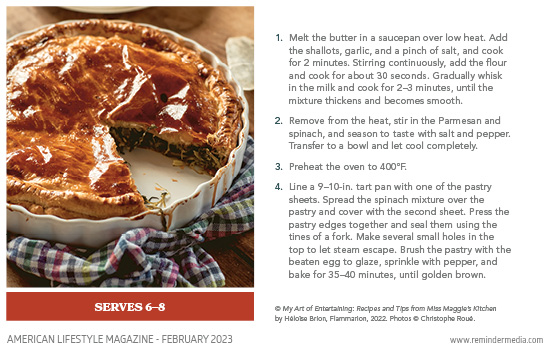February is a time for affection and kindness, so why not give your home some tender loving care this month? These small but important tasks should be easy to accomplish, even though February is the shortest month of the year. Follow this week-by-week organizing challenge to get the most out of your efforts.

Create a proper welcome
Use this opportunity to get rid of grime in your entryway that you might have missed during regular cleanings. Moisten a cloth with warm soapy water, and wipe any dirt off your front door’s interior and scuff marks off adjacent walls and moldings. Add a welcome mat if you don’t already have one to prevent dirt from getting past your home’s entrance.
Tidy a main living area
Pick a space where you spend most of your time, such as your living or family room. Use a basket or a box to collect anything that’s out of place. Give away or toss what isn’t needed, and put other items where they belong. Dust hard surfaces with a microfiber cloth, and vacuum.

Empty and sanitize your freezer
Discard packaged foods with expiration dates that have passed. Foods frozen too long can lose taste and quality, so throw out anything that has been stored longer than a year. If your freezer needs defrosting, move your food to a cooler before doing so. Use a cloth and hot, soapy water to clean your freezer’s interior, and follow up by wiping with a clean, wet rag and towel drying. Use freezer labels to mark your freezer’s contents and freeze dates, and then transfer any remaining food back into your appliance.
Get rid of hidden dust
Months of debris can collect underneath and behind your refrigerator. To remedy this, first pull your refrigerator toward you and unplug it, being careful with your fridge’s water line. Clean the coils in the back of your refrigerator with a duster or a microfiber cloth. (If there is a cover over the coils, you can remove it with a screwdriver.) Vacuum up any dirt that is hidden underneath and behind the fridge. Wipe the walls and the floor with a cloth spritzed with an all-purpose cleaner, and put everything back as it was. If you’d rather not (or cannot) move your fridge, try dusting underneath and behind it with a flat microfiber duster made specifically for cleaning under appliances.
Deep-clean your oven
Chemical oven cleaners and your oven’s deep-cleaning function can fill your home with smoke and fumes. To clean your oven without filling it with smoke, remove the oven racks and soak them in hot, soapy water for a few hours. Make a thick paste of approximately ¾ cup baking soda and ¼ cup warm water, and spread it throughout the inside of your oven, avoiding the door and bare metal surfaces. Let it sit for a few hours or overnight, then remove the paste using a damp cloth or a nonscratch sponge. While the oven door is open, wipe everything but the gasket with equal parts water and vinegar. To help keep your appliance pristine, put a roasting tin on the bottom shelf to catch drippings the next time you cook in it.
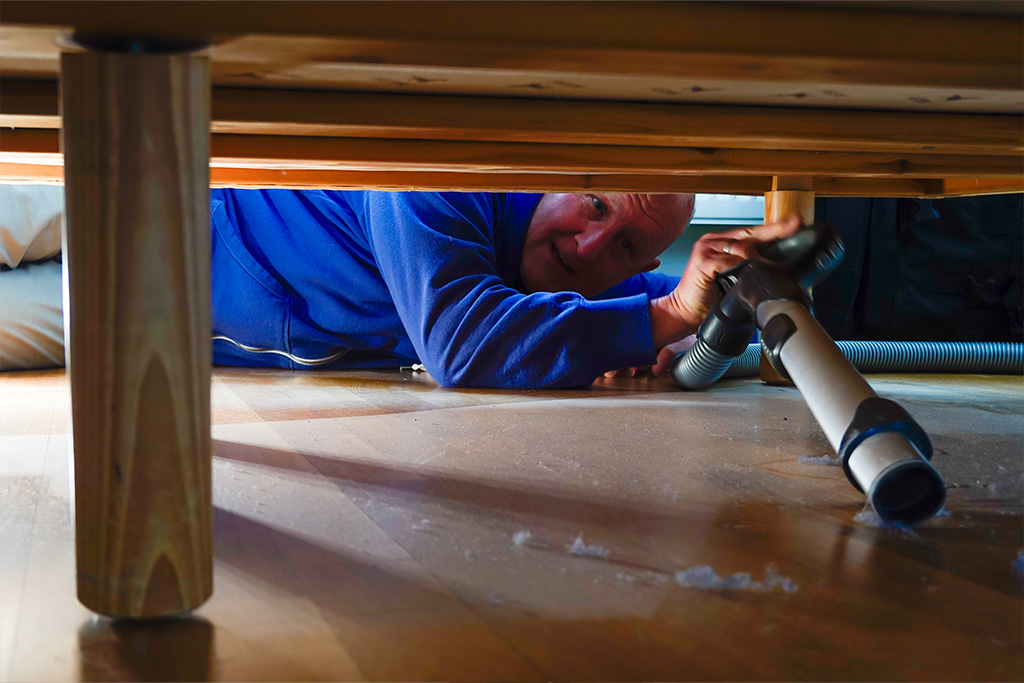
Vacuum underneath furniture
It can be difficult to clean below your bed, sofa, and other heavy furnishings, especially if you have to move them. To tackle these areas, move all the furniture that you can in one room and vacuum where they stood. You can repeat this process in other areas of your home as you have the time. You can also put furniture sliders underneath your furniture to make them easier to move.
Scrub vent covers
The grates over your vents can get quite dusty, especially if they are located high up or behind furniture. Turn your heat off, use a screwdriver to remove the vent covers, and soak them in a bucket of hot, soapy water. Wipe them with a microfiber cloth, rub them dry with a towel, and put them back in place. If you haven’t already done so recently, replace your furnace filter so fresh air can circulate throughout your home.
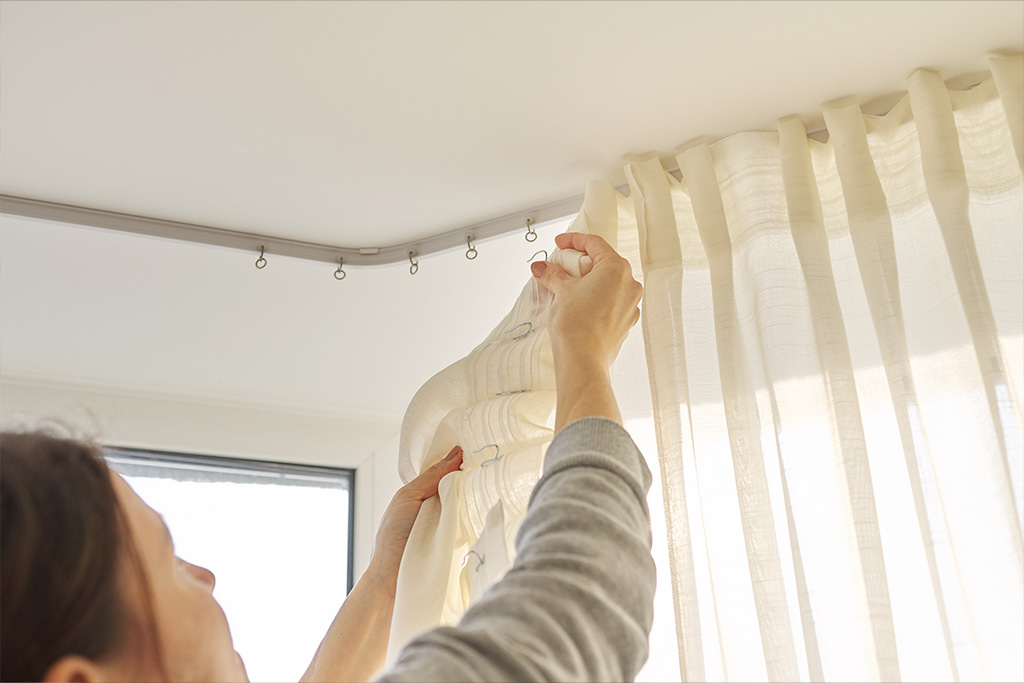
Swap out your curtains
Spring isn’t far away, so switch out heavy drapes with lightweight curtains. If you dress your windows with valances or gauzy panels, more light will flow into your home. You can launder the window dressings you took down and put them away to use later in the year, or you could donate them.
Check safety features
Look for safety updates or upgrades you can make to your home. Make sure you have at least one working fire extinguisher for every level of your home and that they are not past their expiration dates. Verify that your home’s smoke alarms are in working order, and add lighting to poorly lit areas. For example, you could get a motion-sensor night light to illuminate a dark hallway or install solar-powered security lights to brighten your home’s exterior at night for extra security.
Refer to picturesque celebrity homes, and the figures are frankly staggering. For thousands or even millions of dollars, one could appoint their home with the pinnacle of interior design opulence, featuring original work by esteemed decorators, furniture from acclaimed designers, and statement work by renowned artists who have earned household-name status.
It’s understandable to crave such refinement for your own home. However, you can attain the immaculate look of finely curated interiors at a much more reasonable price. The secret lies in employing certain reliable design techniques rather than shelling out for specific products. Start with these six approaches to elegant decor.
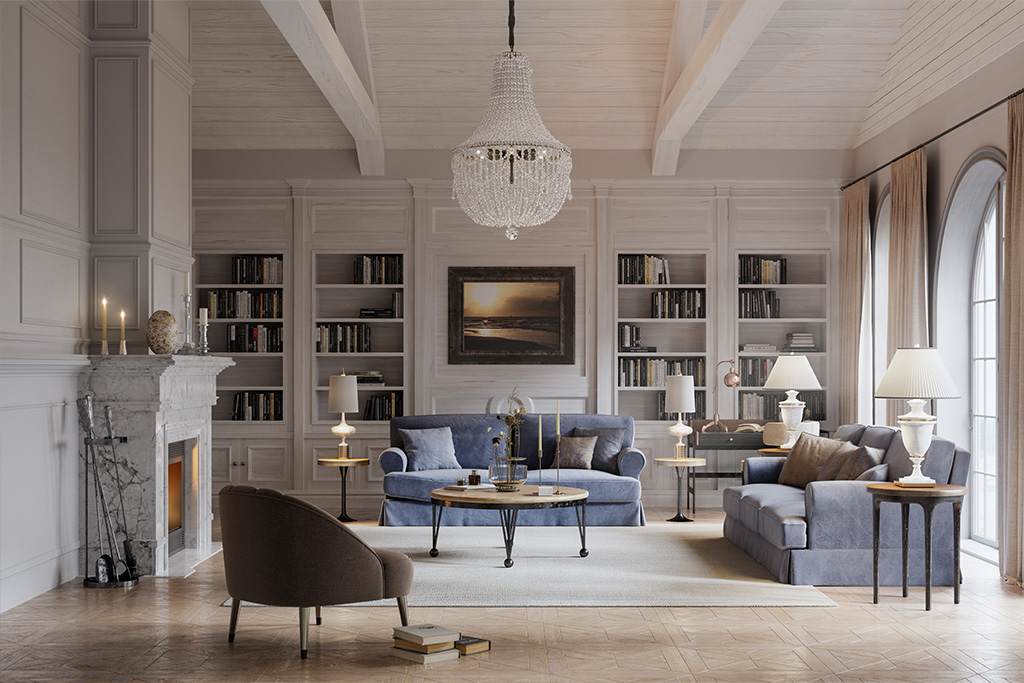
Furniture and decor are often only as impressive as their context, and regarded decorators know how to position goods for maximum impact. A common tactic is to arrange seating at right angles: framing sofas, accent chairs, and ottomans around a large rug and then anchoring seats with proportional end tables and light fixtures. Try to feature similar or even identical lamps in one room for a satisfying motif.
When decorating a large seating area, resist the urge to spread out furniture in a massive sprawl. Instead, separate the room into distinct seating areas, each centered around a table within arm’s reach. Take a hotel lobby for inspiration. To create balance in any room, separate the largest pieces, like credenzas and beds, from one another, peppering in smaller accents like poufs between them.
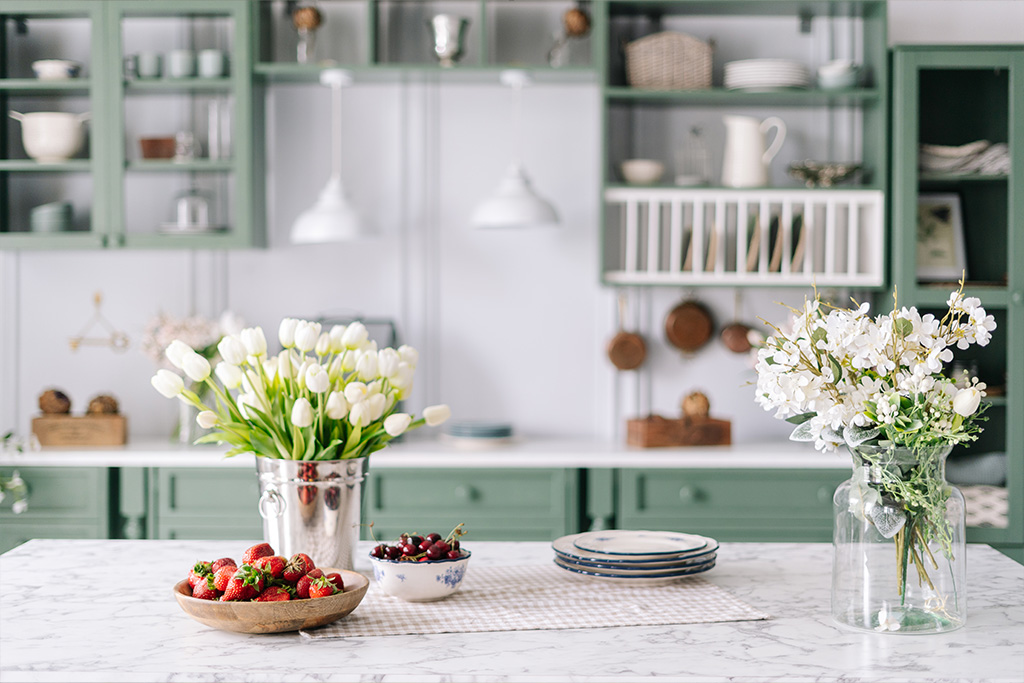
Homes featured in top design outlets use a few reliable staging techniques to make them as photogenic as possible. For one, they’re always completely neat. Rooms indisputably look better when they’re clean and organized, so store your less sightly possessions like remotes, home-office supplies, and small appliances in cabinets whenever possible.
Ornamental plants are so reliable that elegant rooms staged for magazines and even hotel-suite portfolios are rarely staged without fresh flowers. If you’re expecting company, set out a bouquet or a vase with dressings in a high-profile position—like on a cocktail table or kitchen island. Select foliage in an accent color present elsewhere in the room to wow your guests and make any room look more expensive.
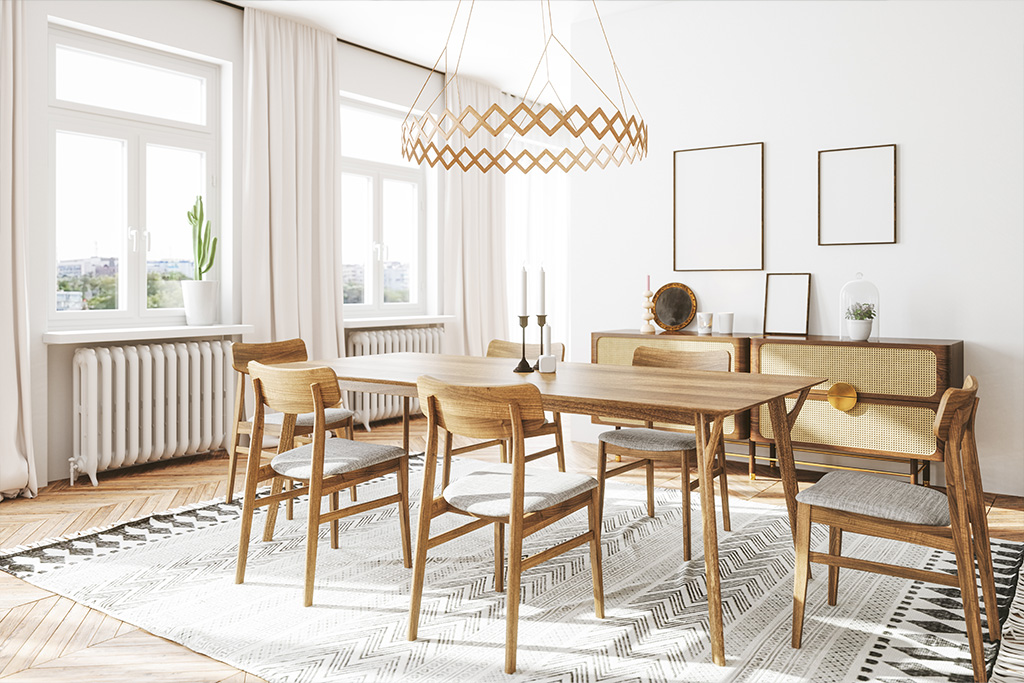
Give new life to antiques or well-worn possessions. If a feature of your home seems outdated or damaged, consider refining it before replacing it. Professional refurbishing services can paint, clean, and modernize furniture for far less than shopping new, and there may even be some projects you can undertake yourself. Restored antiques like mirrors and hutches lend conversational, personal charm to any room. Also, don’t underestimate what a professional rug-care service can do for dusty, stained, or even tattered rugs.
Color is one of the most fickle elements of design; companies like Sherwin-Williams influence the interior decorating world with their designated color of the year. To stay current without throwing your lot into an inherently temporary design trend, consider repainting decorative objects like pottery and candleholders in fashionable colors. “The easiest way to change anything in your home, including glazed ceramics, is with paint,” says design author Diane Henkler of the In My Own Style blog, where she features a helpful guide to repainting lamps and other decor.

Certain small investments can effectively make your home look fresh and current. First, paint over outdated wall colors like primary and pastel shades. Select neutral colors like white or light blue for a calming ambience that also feels refined. Shop for inexpensive accents like pillows, duvets, towels, and decorative pottery, which tend to cycle in and out of fashion faster than larger furniture or wall art do.
You can achieve a lavish look with statement lighting as well. Affordable yet effective, simple drum lampshades can refresh outdated lamps and cover plain ceiling fixtures. Seek affordable fixtures like pendant lights at resale stores for enhanced style. These focal points can center a room without occupying usable square footage.
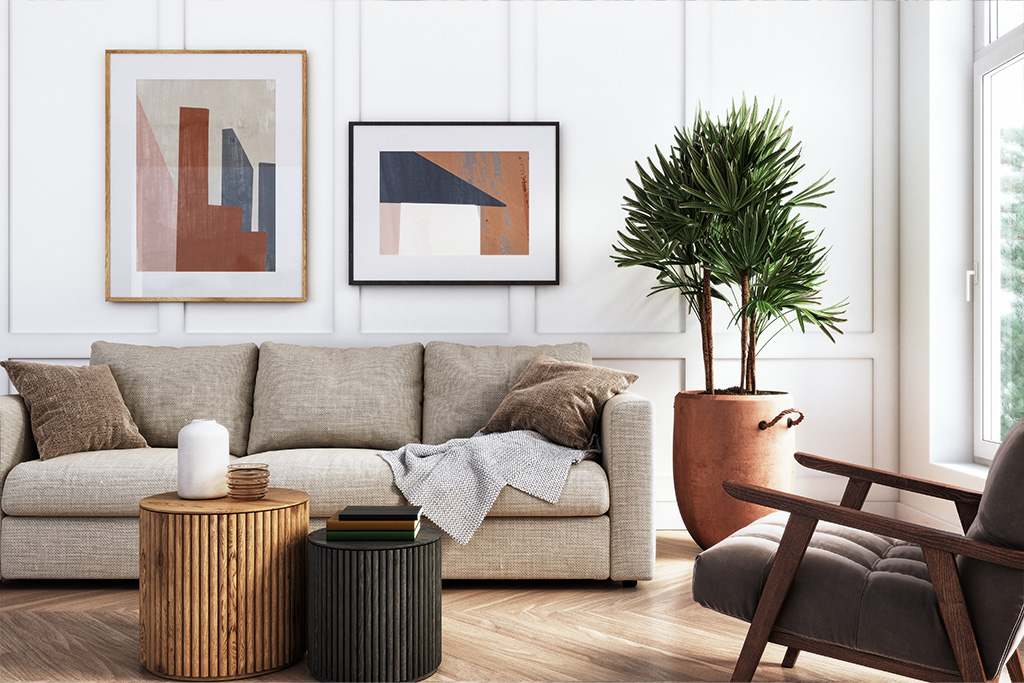
Imitation may be the sincerest form of flattery, but it serves you as well. Imitate the look of luxury homes while shopping for attractive decor within your personal budget.
For example, an authentic Eames chair-and-ottoman set—a golden egg for many high-end, midcentury modern homes—can run in the mid-$6,000s, while a similar set by George Oliver is priced around $1,000. For other statement pieces at a small investment, buy and frame prints from up-and-coming artists. While original art may earn more bragging rights, fine art can drain design funds that could be useful elsewhere.
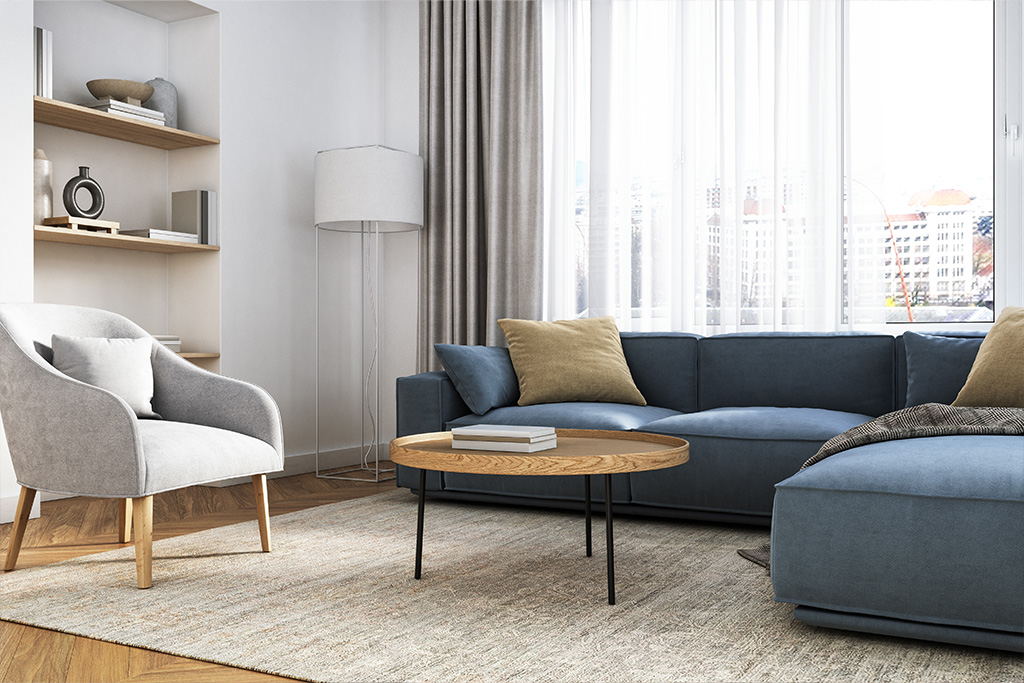
If you’re going to invest in a big-ticket item like a sofa, dining table, or headboard, try to avoid going too trendy. Those who overinvested in a boucle sofa, bubble chair, or farmhouse table may unfortunately find that interior design tastemakers now dismiss them. If you’re looking for a solution to update these pieces, refer back to the “Restore” section above.
To stay timeless, shop for neutral-colored furniture in a classic fabric like cotton or linen. Avoid patterns like stripes, florals, and tropical motifs, which only seem to be appreciated every few decades. And while desert shabby chic and farmhouse decorative trends gradually descend into outdated territory, you can’t go wrong with a transitional design scheme, which seamlessly balances reliable classics with touches of modern elegance.
Financial responsibility isn’t always easy to learn, but it’s an essential part of taking control of your finances and using your income to its fullest. This responsibility can lead to better spending tendencies that can, in turn, help you pay off your debts faster and build up savings to protect you in the future. So if you’ve struggled to stay on top of your spending, here are a few key ways you can adjust your habits and mindset to better meet your financial goals.

Budgeting is a great first step toward managing your finances. In fact, according to a survey conducted by the Certified Financial Planner Board, people who budget feel more financially secure and confident than those who don’t. When you budget, you’re being strategic with your spending and controlling where your money goes each month. Budgeting strategies like the 50/30/20 method—where 50 percent of your income goes toward necessary living expenses, 30 percent is spent on your additional wants like eating out and entertainment, and 20 percent is put directly into savings—can help you create a realistic budget and become more financially responsible and secure.
It’s essential to know what bills you must pay each month and when they’re due since missing one can hurt your credit score and end up costing you more money. It’s a good idea to have a spreadsheet that lists all your recurring expenses and their due dates. If spreadsheets aren’t your thing, you can instead use an app like Mint or even just make a note on your phone to better track your recurring expenses. It’s also important to automate your payments so you won’t have to actively think about them. Whatever method you opt for, tracking bills and expenses can help you keep up with your spending and give you an idea of how much will be coming out of your account and when.

Many people receive an allowance growing up, but this tends to stop when you’re an adult and start earning a paycheck. However, setting up a weekly spending allowance for yourself can help you cut back on excess spending. You can set aside cash for each week or simply have a set number in mind to put on your debit or credit card. Either way, an allowance shows you how much money to dedicate to lunches, coffee, home goods, and anything else that you might want to buy in a given week. Having a specific number helps you to say no to that extra dinner out and instead save money by making something at home.
Setting aside a specific portion of your income each month can help you save for an upcoming trip, additional spending during the holidays, or emergency expenses. Putting money directly into your savings can give you a sense of security, so look at it as a payment to your future self. You’re preventing potential headaches down the road when it comes time to spend extra money on something, and you’ll be grateful that you had the forethought to put money away when you did.

Before making an expensive purchase, be it for a new piece of furniture or a nice outfit, it’s important to think it through. You don’t want to make a rash decision, especially if the item far exceeds what you’re used to spending. Give yourself some time to consider the purchase and plan out how you’re going to save for it. You can set aside money every paycheck for the item, allocate funds outside of your usual savings, or, if you’re dipping into your savings, check to make sure the purchase won’t bring the total amount too low for comfort. Taking control of your spending is about being strategic with your purchases and giving big expenses more consideration than you may have in the past.
Credit cards can be a great financial tool to have, but paying off the full balance every month is an important part of being more financially responsible. Just as important, they often have high interest rates that can significantly increase your debt if you don’t pay the entire balance—so it’s important to manage them the best you can. If you find that you can’t pay the full amount each month, consider adjusting your spending habits. Instead of picking up coffee every morning, eating all your lunches out, or adding a new item to your virtual cart every day, you can save money by making your own coffee and lunches and cutting back on your online shopping. These expenses may not seem like a lot in the moment, but they can quickly add up and create a high monthly balance that isn’t always easy to pay in full.

To make sure that you’re continuing to stay on top of your finances, you want to regularly review your spending. Look at your credit card statements and your savings and checking accounts, and see what you are spending your income on each month. Carefully reviewing your accounts can help you better understand your financial habits and see where perhaps you’re spending too much and need to cut back. It’s simply a way to hold yourself accountable, allowing you to adjust your spending accordingly.
By taking a few easy steps to better control your spending, you can manage your finances and become more financially secure.
Winter is an ideal time to prepare your favorite comfort foods, and these delicious yet simple recipes from Héloïse Brion’s cookbook My Art of Entertaining will satisfy as family meals or inviting dishes at get-togethers.
This rich, hearty onion soup is bursting with spicy, citrusy flavor and enhanced by the crunch of baked coppa.
Easy as pie to make, this tasty, flaky dish is perfect as a meal, an appetizer, or a yummy snack.

©My Art of Entertaining: Recipes and Tips from Miss Maggie’s Kitchen by Héloïse Brion, 2022. Photography © Christophe Roué.
recipe by héloïse brion
photos by christophe roué

Serves 4–5
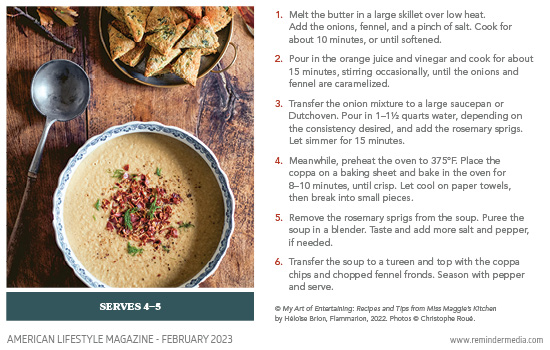

recipe by héloïse brion
photos by christophe roué

Serves 6–8
Kitchen notes: This pie is delicious served hot or at room temperature, with a fresh green salad on the side.
